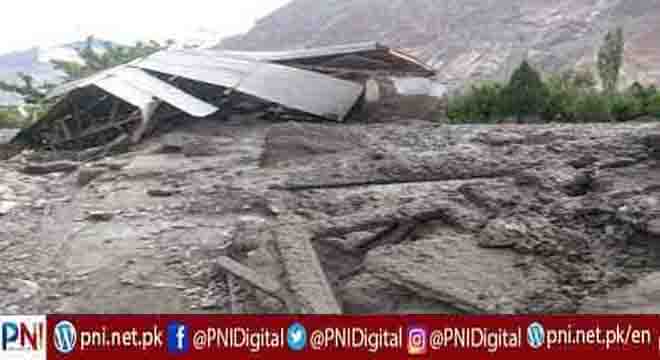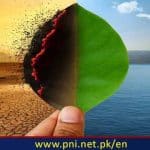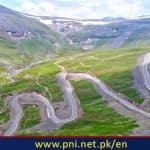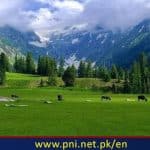PESHAWAR, Sep 25 (APP): Notwithstanding the climate change-induced floods, the wildlife was one of the most affected sectors following destruction of its habitats, sanctuaries and protected areas in Khyber Pakhtunkhwa where an estimated Rs97.64 million losses were reported.
Breaking the 30 years record, the August 27 devastating floods, which started from Mataltan, Osho, Uthror and Upper Kalam valleys in Swat washed away everything that came across its way including the aquatic species and wildlife sanctuaries.
Swat, Chitral, Kohistan, Manshera and Abbottabad were among the worst affected areas in terms of substantial damages caused to wildlife by the flash floods.
The gushing water has mostly engulfed the wildlife’s habitats, conservancies, watchers huts, national parks, peasantries and protected areas in these districts by inflicting huge losses to wild mammals, reptiles and birds.
“The destruction of wildlife and aquatic species’ habitats and sanctuaries by the recent flash floods was apparently linked to the climate change. Pakistan for so many years remained among the 10 countries most vulnerable to climate change and no solid efforts were made by the international community to help it to counter this monster challenge,’” said Dr Mumtaz Malik, former Chief Conservator of Forests KP while talking to APP.
Showing his grave concerns over the loss of precious water, he said “climate change has two dimensions whether there may be a lot of water in the shape of floods or drought in result of minimum rainfall and in both the situations the wildlife and aquatic resources were the biggest victims.”
The wildlife guru said that 90 different wildlife species including siberian crane, white backed vulture, long-billed vulture, red-headed vulture, saker, peregrine falcons, hawksbill sea turtle, Kashmir grey langur, indus dolphin, finback whale, Baluchistan bear, musk and hog deers, pangolin, egyptian vulture, green turtle and narrow-headed turtle were endangered by the climate change.
Dr Mumtaz said around 786 wildlife species found in Pakistan including 186 reptiles and 173 mammals, and about 90 species including 50 mammals, 27 birds and 17 reptiles were placed in categories of endangered, vulnerable and near to extinction.
He said floods and drought destroy wildlife’s flora at their grazing habitats especially in wet lands as well as in high alpine pasture areas and in such situation they come down to lower areas for food sometimes attacked humans and exposed themselves to be hunted.
He said we should not forget the devastations of 2010 flood, worst drought conditions during 1999-2003, cyclones in Karachi and Gawdar coasts in 2008, Glacial Lake Outburst Floods (GOLFs) of Atabad Lake in Gilgit Baltistan, Chitral, July 28, 2021 flood in Islamabad, Murree’s snowfall tragedy 2021 and over 1,500 human losses in the recent floods.
“The most concerning thing was that the flash floods washed away fertile soil in forest areas that were providing breeding ground and sanctuaries to the wild animals for regeneration of new plants and thickening of jungles,” Dr Mumtaz said. He added that reptiles were among the most affected wildlife in floods areas and the recent increase in the snake bites cases was due to damage of their sanctuaries.
“Pakistan accounts for less than one percent of total global emissions and the developed countries need to come forward and help our over 30 million flood victims in this hour of need after nearly 1/3 of Pakistan was drowned in the unprecedented floods water.” He said huge revenue was wasted after washing of timber in flood water in Swat and Kohistan.
The KP’s wildlife department officials told APP that Rs1.300 million losses were estimated in wildlife division Chitral, Rs3 million in Chitral Gol national park, Rs20 million in Lower Swat, Rs eight million in Manshera, Rs14 million in Kohistan and Rs 3.34 million in Bannu.
Upper Swat and Abbottabad were the worst affected areas in terms of floods losses to the wildlife infrastructure and their habitats where Rs40 million and Rs26 million losses were estimated respectively.
In Chitral Gol national park, he said three watcher huts and 25 kilometers roads and tracks were damaged inflicting Rs1 million and Rs two million losses respectively.
Likewise, Fizagut peasantry at tehsil Babuzai in Swat on 0.1937 acres were also damaged. As result of which eight different types of birds including Reeves, White True, Lady Amherst, Wood Green, Silver and ring-nected pheasants were affected, causing Rstwo million losses.
Saiful Malook National Park, which was known for Persian Prince Saiful Malook and Badri Jamala’s fairy tale in Upper Kaghan valley in Manshera district where habitats situation of 16 acres of water body at inlet of famous lake were affected thus causing Rs eight million losses.
Information centre and brids cadges with 15 number of birds in Lakki Marwat with Rs.04 million and Rs3.3 million damages to the infrastructure of SDFO Lakki Marwat sub division.
Watcher huts of Paloga Mahudhand and Baila Gujar Gabral in Upper Swat was also swept away by the gushing water. The 120 acres land of Shahi Bagh, Gabral, Pishmal, Kharkhary, Mahudhand in Kalam conservancy was washed away besides different types of plants species including deodara, smithiana and pindrow causing Rs20 million.
Similarly, Rstwo million losses were estimated to wildlife pheasantry at Dassu and Rs12 million to watch huts at Pattan Lower Kohistan.
Besides Rs1.3 million damages to Uglugol watcher hut at Chitral Upper Rs six million damages were reported to infrastructure of the DFO Wildlife residence and Rs20 million to SDFO Wildlife in Abbottabad.
Dr Mumtaz said that government needs to divert resources to forest and wildlife resources for its reconstruction and rehabilitation programs in post floods period to protect the wild species and green gold in future.
Follow the PNI Facebook page for the latest news and updates.








